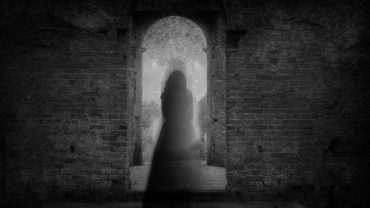Every schoolchild in England grows up with tales of St George, the nation’s patron saint, gallantly slaying a dragon to save a princess and a village. But the English countryside bristles with legends of other such creatures – slithering, winged, fire-breathing beasts who terrorised hamlets, haunted hills, and met a variety of ends.
These are the dragons that escaped St George’s sword, lurking in folktales, church carvings, and place names. Join us as we explore the English dragons that weren’t slain by St George.
What’s in a Name? Worms, Wyverns, and Dragons

An old engraved illustration of a wyvern (Credit: mikroman6 via Getty Images)
Before we begin naming names, it’s worth clarifying the different terminology used to describe dragons in English folklore. Here’s the rundown:
- Worms – or “wyrms” – come from the Old English wyrm, meaning serpent. They’re often described as legless, snakelike monsters – massive, coiling creatures that wrap themselves around hills or slither into wells.
- Wyverns typically have wings and two legs, rather than the four-legged, winged dragons of European heraldry. These are swift, aerial predators in many stories, often shown with barbed tails or venomous breath.
- Knuckers are a more localised breed, mostly found in southern England – especially Sussex. These water-dwelling dragons were said to have lived in deep, seemingly bottomless ponds known as knuckerholes. They were said to be serpentine but with legs and sometimes wings, and often blamed for drownings, livestock deaths, and the occasional disappearance. Unlike mountain-dwelling dragons, knuckers kept close to water and emerged only to feed.
- The more general “dragon” is a catch-all term, used in both mythology and later literature to describe fire-breathing beasts with four limbs, wings, and a terrible temper.
These terms were used loosely in folk stories, and often interchangeably. But the distinctions reflect a fascinating variety of local monster design – each adapted to the landscape, the fears, and the imaginations of the communities that birthed them.
1. The Lambton Worm | County Durham

Did the Lambton Worm terrorise locals in County Durham? (Credit: HPuschmann via Getty Images)
County Durham is home to what might be England’s most famous non-St George dragon. The legend goes that John Lambton, a rebellious young nobleman, skipped church one Sunday to go fishing. He caught a wriggling, eel-like creature and tossed it down a well. Years later, returning from the Crusades, he found the worm had grown into a massive dragon, coiled around a nearby hill, terrorising locals and demanding regular meals of milk and livestock.
John decided to slay the beast. But he was warned of a curse. John eventually slew the beast by donning spiked armour and luring it into battle. But he did not emerge unscathed. The story ends darkly—John had been warned that, after slaying the worm, he must kill the first living thing he saw, or his family would be cursed for nine generations. This ended up being his father. He couldn’t do it. The Lambtons, they say, suffered misfortunes for centuries.
2. The Mordiford Wyvern | Herefordshire

The Mordiford Wyvern may have disappeared into the Herefordshire forests. (Credit: dottedhippo via Getty Images)
A beloved pet turned fearsome predator, the Mordiford dragon began life as a harmless hatchling near the River Lugg, outside the Herefordshire village of Mordiford. There it was found by a little girl called Maud, who raised it in secret. As it grew, it became a menace to the locals – all except Maud.
Eventually, the villagers could take no more and made attempts to defeat it. There are many variations on the story’s end. Some versions say a man named Garstone, possibly a knight, was hired and killed it. There are further versions which tell of Maud dying of heartbreak. Meanwhile, other local legends hint the dragon managed a narrow escape, vanishing into the forest and folklore.
3. The Lyminster Knucker – West Sussex

The Lyminster Knucker spread fear over West Sussex (Credit: SeanEvisonSussex via Getty Images)
In the folklore-rich soil of Sussex, few dragons are as infamous – or as fondly remembered – as the Knucker of Lyminster. For one thing, unlike other knuckers – water monsters – it may have also been capable of flight. Local accounts describe a beast that not only lurked in the depths but could rise into the skies, spreading terror over fields and villages.
The legends surrounding the Knucker’s death are as tangled as the reeds around its watery lair. In one version, it was slain by a knight after the King of Sussex offered his daughter’s hand in marriage to anyone brave enough to do so. Another telling gives credit to a humble local lad named Jim Puttock, sometimes known as Jim Pulk. Lacking swordplay but not ingenuity, Jim baked an enormous poisoned pie and carted it to the edge of the knuckerhole. The dragon, ever greedy, devoured the pie in one gulp – horse, cart, and all – and promptly died. In some versions, poor Jim also perished, either from contact with the dragon’s toxic blood or by sampling his own deadly dish.
4. The Wantley Dragon | Yorkshire

The Wantley Dragon about to devour three children... (Credit: powerofforever via Getty Images)
Something a little bit different now in South Yorkshire, with a farcical twist on dragon lore. Immortalised in the comic poem The Ballad of the Wantley Dragon in 1685, this particular beast rampaged across the countryside consuming children, maidens, livestock, and all the usual dragon fare. But it also went above and beyond, ingesting entire buildings.
Described as nearly the size of a Trojan horse, with “two furious wings,” a tail “as long as a flail,” and “four and forty teeth of iron,” the Wantley Dragon was wrapped in an impenetrable hide. This latter attribute made sword-slaying out of the question. Thus, it finally met its end not at the hands, but rather the boot, of a local hero. All it took was a single, well-aimed kick to the creature’s only vulnerable spot: its backside.
5. The Dragon of Longwitton | Northumberland

The Dragon of Longwitton was said to live in Northumberland (Credit: Chris Lishman via Getty Images)
Described as a vast, coiling beast with venomous breath and a long black tongue, one would imagine that the Dragon of Longwitton would struggle to blend into the background. But this mythical monster did one better, possessing a power to vanish and reappear at will.
As the story goes, the beast took up residence at Longwitton Hall. There it guarded three ancient wells with miraculous healing properties, preventing anyone from approaching. Many tried to kill it, only to find that it would vanish, making it impossible to strike. Then came a young knight, sometimes named as Sir Guy, Earl of Warwick. Armed with a magical ointment that revealed hidden things, the knight could finally see his elusive foe.
Yet even with eyes on the beast, victory did not come easily. Each wound the knight inflicted healed instantly – the dragon had cleverly dipped its tail into the healing waters of the wells, drawing strength and regeneration from them throughout the battle. After two fruitless days of combat, the knight changed tactics. On the third day, he feigned retreat, luring the dragon from the spring and dealing a deadly blow.
6. The Dragons of St. Leonard’s Forest | Sussex

St Leonard of Noblac (Credit: AmandaLewis via Getty Images)
St. Leonard’s Forest in West Sussex is the site of not one, but two dragon legends. The first relates to its namesake, Leonard of Noblac, who’s said to have slain a dragon there in the sixth century. He was injured in the fight and, as legend has it, lilies-of-the-valley grew where his blood fell. To this day, wild lilies grow in abundance in certain parts of St. Leonard’s Forest.
Hundreds of years later, in the early 17th century, there were reports of a monstrous serpent or dragon in the same area. According to a pamphlet published in 1614, it had red and black scales along its nine-foot long body, two hunches on its back, and could spit lethal venom. The fate of this second dragon is unknown, but sightings were said to have continued into the 18th century.
7. The Ludham Dragon | Norfolk

St Catherine's Church in Ludham (Credit: Julian Elliott Photography via Getty Images)
Legend tells of a dragon up to 15 feet long that made its home in a labyrinth of tunnels beneath the village of Ludham, not far from St Catherine’s Church. It would emerge from the marshes to terrify livestock and villagers, its long body glinting in the sun as it basked outside its lair. One day, as it lay sunning itself, a local resident seized the moment, rolling a massive boulder into the tunnel entrance and sealing it shut. Realising it had been cut off from its home, the dragon flew into a rage and vanished into the skies, never to return.
The legend may trace its roots to a real event: the killing of an unusually large snake in Ludham, reported in the Norfolk Chronicle on 28 September 1782.
8. The Bures Dragon | Suffolk

Did the Bures dragon retreat to the nearby River Stour? (Credit: Stephen Dorey via Getty Images)
In 1405, a monk by the name Henry de Blaneford wrote about a fearsome creature that killed a shepherd and his flock near the village of Bures. Describing it as of “excessive length,” with a huge body, crested head, saw-like teeth, and an elongated tail, he told of how attempts to pierce its hide with arrows proved futile. After one such confrontation, the Bures Dragon retreated into the nearby marshes and was never seen again. The story has endured through the centuries, and today it’s commemorated by a 100-foot long chalk dragon carved into the hillside near Bures.
9. The Brent Pelham Dragon | Hertfordshire

The village of Brent Pelham in Hertfordshire (Credit: Gary Yeowell via Getty Images)
Said to be the Devil’s favourite dragon, the beast that terrorised Brent Pelham in the 11th century was no ordinary serpent. Breathing fire and sowing destruction, it prowled the woods near the village until it was confronted by Piers Shonks – a legendary figure some tales describe as a giant standing 23 feet tall.
Shonks killed the dragon by driving a holy sword through its throat. Enraged, the Devil vowed to claim his soul. To outwit him, Shonks arranged to be buried neither inside nor outside the church, but within its very wall, cheating the Devil of his due. His tomb, dated 1086 and carved with a winged serpent and sword, can still be seen in St Mary’s Church today, along with the following epitaph:
“Nothing of Cadmus nor St. George (those names of Great renown) survives them, but their fames; Time was so sharp set as to make no bones of theirs, nor of their monumental stones. But Shonke one serpent kills, t’other defies, and in this wall as in a fortress lies.”
10. The Bisterne Dragon | Hampshire

Bolton's Bench, where the Bistern Dragon was slain (Credit: merlinpf via Getty Images)
Of all the dragons in the land – England that is – it’s the one from Bisterne who arguably had the most esoteric of requirements. Every day, it would fly from its lair at Burley Beacon to nearby Bisterne to demand milk. At least that’s how most versions tell it. And who can blame it? A growing dragon needs its calcium. Eventually slain by a local knight, Sir Maurice Berkeley, the site of the dairy-loving dragon’s death is known as Bolton’s Bench and is still marked today. There’s also a nearby wooden sculpture of the beast.
The Tail End: Wrapping Up Our Dragon Hunt

St. George & The Dragon (Credit: stocknshares via Getty Images)
While Saint George and his slain dragon are the best known in English legend, there are plenty more peppered throughout its green and pleasant land. What’s more, English dragons often feel tied to the land itself: carving valleys and hills, dwelling in waterholes, and haunting forests.












